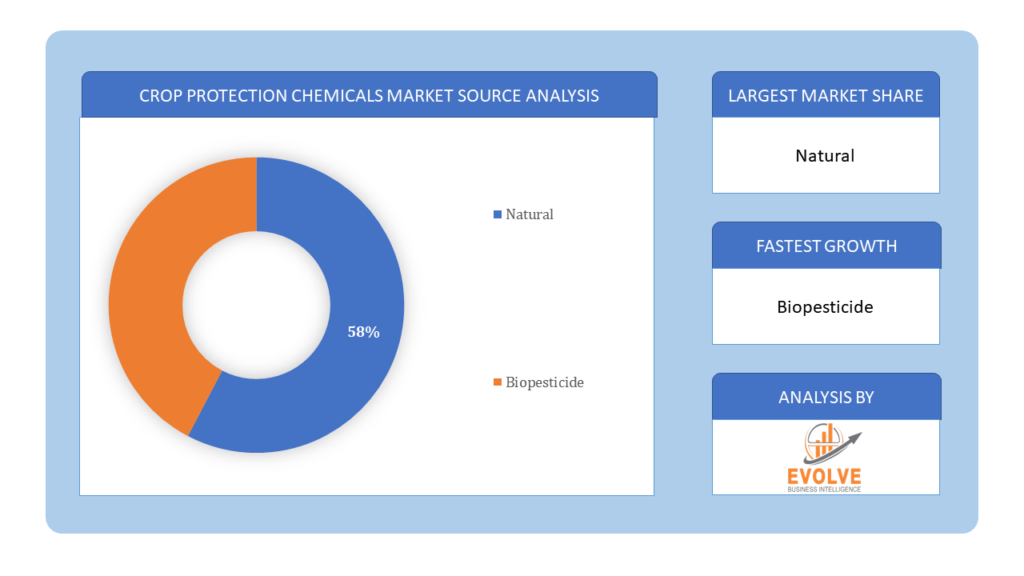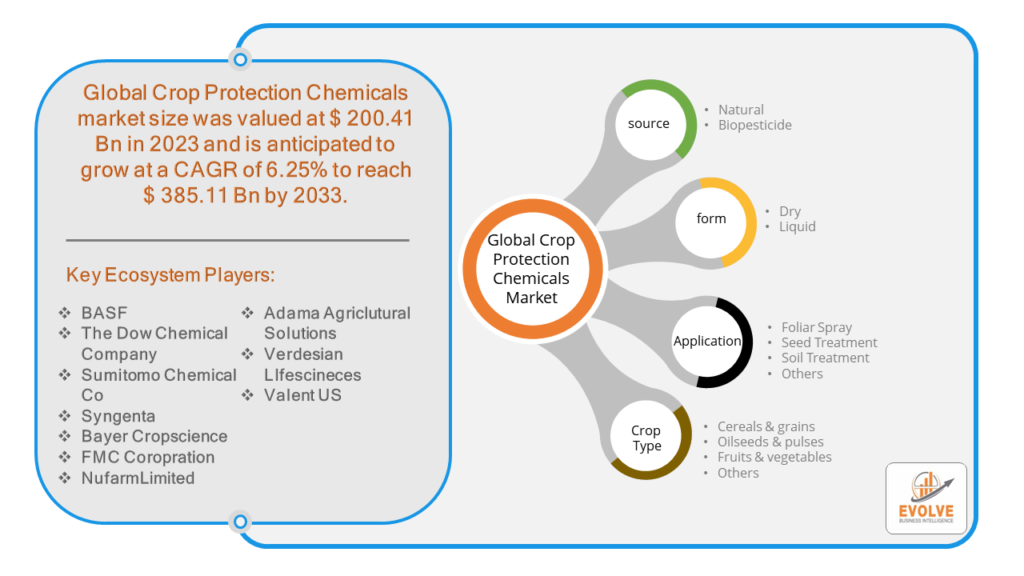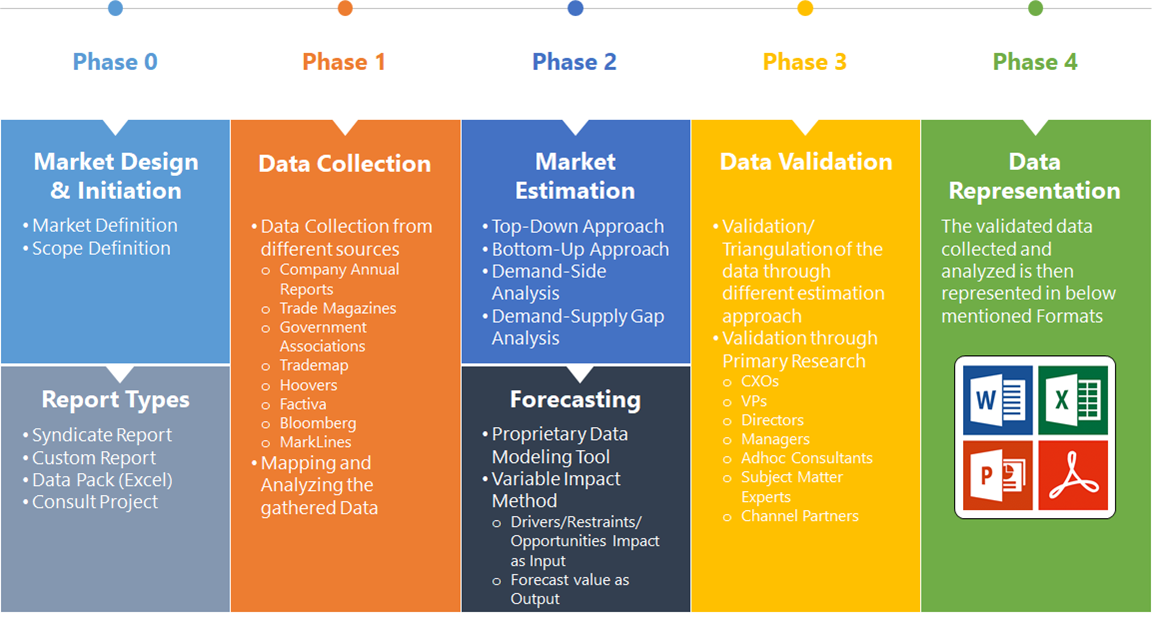Crop protection chemicals market Overview
The Crop protection chemicals market Size is expected to reach USD 92.77 Billion by 2033. The Crop protection chemicals market industry size accounted for USD 43.25 Billion in 2023 and is expected to expand at a compound annual growth rate (CAGR) of 4.26% from 2023 to 2033. The crop protection chemicals market refers to the industry involved in the production, distribution, and sale of chemicals used to protect crops from pests, diseases, and weeds. These chemicals, also known as pesticides or agrochemicals, are essential for modern agriculture to ensure high yields and prevent significant losses due to various biological threats.
Factors driving the demand for crop protection chemicals include the need to increase agricultural productivity to meet the growing global food demand, the prevalence of pests and diseases that can devastate crops, and the adoption of modern farming practices that rely on intensive crop management. Crop protection chemicals are utilized across various agricultural sectors, including arable farming, horticulture, and forestry.
Global Crop protection chemicals market Synopsis
The COVID-19 pandemic had several notable impacts on the crop protection chemicals market. Lockdowns, restrictions on movement, and disruptions in transportation have affected the supply chain of crop protection chemicals. This has led to delays in the delivery of raw materials, manufacturing disruptions, and logistical challenges, impacting the availability of these chemicals for farmers. The pandemic has caused shifts in demand for certain types of crops and consequently for specific crop protection chemicals. Economic disruptions caused by the pandemic, including reduced farm incomes and uncertainties in agricultural markets, may have affected farmers’ ability to afford crop protection chemicals. Some farmers may have reduced their usage or opted for cheaper alternatives, impacting sales in the market. The pandemic has also influenced regulatory activities related to crop protection chemicals. Regulatory agencies may have adjusted timelines for product registrations, inspections, and other activities, impacting the introduction of new products and the compliance of existing ones.
Crop protection chemicals Market Dynamics
The major factors that have impacted the growth of Crop protection chemicals market are as follows:
Drivers:
Ø Growing Food Demand
As the global population continues to increase, so does the demand for food. This necessitates higher agricultural productivity to ensure food security and meet the nutritional needs of a growing population. Crop protection chemicals play a crucial role in this by helping farmers protect their crops from pests, diseases, and weeds, thus maximizing yields and ensuring a reliable food supply. With the expansion of agricultural land to accommodate the growing population’s food needs, there is an increased risk of encountering new pests, diseases, and weeds. Crop protection chemicals provide farmers with the tools to manage these challenges effectively, allowing for the cultivation of crops in previously uncultivated or less productive areas. Advances in agricultural biotechnology and chemistry have led to the development of more effective and targeted crop protection chemicals. New formulations, active ingredients, and application techniques allow for better pest and disease control while minimizing environmental impact and reducing the risk of resistance development.
Restraint:
- Perception of Public Perception and Consumer Demand
Heightened awareness of environmental and health concerns associated with chemical pesticides has led to changing consumer preferences and market demand for safer and more sustainable agricultural practices. Consumers are increasingly seeking food products that are produced using fewer chemical inputs, leading to a shift towards organic and sustainably produced crops. This trend can limit the market growth of conventional crop protection chemicals and drive demand for alternative pest management solutions. Prolonged and intensive use of crop protection chemicals can lead to the development of resistance in pest and weed populations. This resistance reduces the effectiveness of chemical control methods, requiring higher application rates or the use of alternative products.
Opportunity:
⮚ Growing Demand for Sustainable Agriculture
There is a rising global awareness of the environmental and health impacts associated with conventional chemical pesticides. Consumers, regulators, and stakeholders are increasingly advocating for sustainable agricultural practices that minimize chemical inputs, reduce environmental pollution, and promote biodiversity conservation. This presents an opportunity for manufacturers to develop and market crop protection products that align with these sustainability goals. Advances in digital agriculture technologies, including remote sensing, data analytics, and precision application systems, offer opportunities to optimize crop protection practices and reduce chemical usage. Precision farming technologies enable farmers to target inputs more precisely, apply crop protection products only where and when needed, and monitor pest populations in real-time. Manufacturers can collaborate with technology providers to develop integrated digital solutions that enhance the efficacy, efficiency, and sustainability of crop protection strategies.
Crop protection chemicals market Segment Overview
By Source
 Based on Source, the market is segmented based on Natural and Biopesticide. Biopesticide segment is dominant the market. Biopesticides are generally considered safer for the environment, non-target organisms, and beneficial insects compared to synthetic chemical pesticides. Biopesticides often target specific pests or pathogens while leaving beneficial organisms unharmed, minimizing disruption to ecosystems and natural biological control mechanisms.
Based on Source, the market is segmented based on Natural and Biopesticide. Biopesticide segment is dominant the market. Biopesticides are generally considered safer for the environment, non-target organisms, and beneficial insects compared to synthetic chemical pesticides. Biopesticides often target specific pests or pathogens while leaving beneficial organisms unharmed, minimizing disruption to ecosystems and natural biological control mechanisms.
By Form
Based on Form, the market segment has been divided into Dry and Liquid. liquid accounted for the largest market share. Liquid formulations offer convenience and ease of application. They can be easily mixed, sprayed, and distributed over large areas, allowing for efficient coverage of crops. Liquid formulations can be applied using various equipments such as sprayers or irrigation systems, making them suitable for different farming practices and crop types. This versatility and convenience make liquid formulations a preferred choice for many farmers.
By Application
Based on Application, the market segment has been divided into Foliar Spray, Seed Treatment, Soil Treatment and Others. The foliar spray segment dominated the crop protection chemicals market. The foliar spray is the most common application method for crop protection chemicals. Although it can be used for herbicides, insecticides, and fungicides, it is mostly used to spray herbicides and insecticides due to the shortage of labor needed to remove unwanted weeds manually and destroy insect attacks on crops.
By Crop Type
Based on Crop Type, the market segment has been divided into Cereals & grains, Oilseeds & pulses, Fruits & vegetables and Others. Cereals and grains segment dominant the largest market. Cereals and grains are staple food crops consumed globally, forming the foundation of many diets. The demand for these crops is consistently high, driven by factors such as population growth, changing dietary preferences, and increasing urbanization. As a result, the production and protection of cereals and grains receive significant attention from farmers, leading to a higher demand for crop protection chemicals.
Global Crop protection chemicals market Regional Analysis
Based on region, the global Crop protection chemicals market has been divided into North America, Europe, Asia-Pacific, the Middle East & Africa, and Latin America. North America is projected to dominate the use of the Crop protection chemicals market followed by the Asia-Pacific and Europe regions.
 Crop protection chemicals North America Market
Crop protection chemicals North America Market
North America holds a dominant position in the Crop protection chemicals market. The United States and Canada have well-established agricultural sectors with high adoption rates of crop protection chemicals. Regulatory agencies such as the Environmental Protection Agency (EPA) in the U.S. and Health Canada regulate the registration and use of pesticides, influencing market dynamics. Increasing concerns about pesticide residues, environmental pollution, and pesticide resistance have led to greater demand for sustainable and integrated pest management solutions.
Crop protection chemicals Asia-Pacific Market
The Asia-Pacific region has indeed emerged as the fastest-growing market for the Crop protection chemicals market industry. Asia-Pacific is a diverse region with a wide range of agricultural practices, from smallholder farming to large-scale commercial agriculture. Countries like China, India, and Southeast Asian nations are major consumers of crop protection chemicals due to high agricultural output and pest pressure. Rapid urbanization, changing dietary habits, and increasing food demand are driving the adoption of modern agricultural practices and crop protection chemicals in the region.
Competitive Landscape
The global Crop protection chemicals market is highly competitive, with numerous players offering a wide range of software solutions. The competitive landscape is characterized by the presence of established companies, as well as emerging startups and niche players. To increase their market position and attract a wide consumer base, the businesses are employing various strategies, such as product launches, and strategic alliances.
Prominent Players:
- BASF
- The Dow Chemical Company
- Sumitomo Chemical Co
- Syngenta
- Bayer Cropscience
- FMC Coropration
- NufarmLimited
- Adama Agriclutural Solutions
- Verdesian LIfescineces
- Valent US
Key Development
In June 2020, BASF and TECNALIA, a European center for research and technological development, are collaborating in digitalization to accelerate the global research and development of new crop protection products.
In August 2022, Syngenta acquired two next-generation bioinsecticides, NemaTrident and UniSpore, to further enhance their biocontrol technology. These developments highlight Syngenta’s commitment to providing farmers with advanced and sustainable solutions for crop protection.
Scope of the Report
Global Crop protection chemicals Market, by Source
- Natural
- Biopesticide
Global Crop protection chemicals market, by Form
- Dry
- Liquid
Global Crop protection chemicals market, by Application
- Foliar Spray
- Seed Treatment
- Soil Treatment
- Others
Global Crop protection chemicals market, by Crop Type
- Cereals & grains
- Oilseeds & pulses
- Fruits & vegetables
- Others
Global Crop protection chemicals market, by Region
- North America
- US
- Canada
- Mexico
- Europe
- UK
- Germany
- France
- Italy
- Spain
- Benelux
- Nordic
- Rest of Europe
- Asia Pacific
- China
- Japan
- South Korea
- Indonesia
- Austalia
- Malaysia
- India
- Rest of Asia Pacific
- South America
- Brazil
- Argentina
- Rest of SouthAmerica
- Middle East &Africa
- Saudi Arabia
- UAE
- Egypt
- SouthAfrica
- Rest of Middle East & Africa
| Parameters | Indicators |
|---|---|
| Market Size | 2033: $92.77 Billion |
| CAGR | 4.26% CAGR (2023-2033) |
| Base year | 2022 |
| Forecast Period | 2023-2033 |
| Historical Data | 2021 |
| Report Coverage | Revenue Forecast, Competitive Landscape, Growth Factors, and Trends |
| Key Segmentations | Source, Form, Application, Crop Type |
| Geographies Covered | North America, Europe, Asia-Pacific, Latin America, Middle East, Africa |
| Key Vendors | BASF, The Dow Chemical Company, Sumitomo Chemical Co, Syngenta, Bayer Cropscience, FMC Coropration, NufarmLimited, Adama Agriclutural Solutions, Verdesian LIfescineces and Valent US. |
| Key Market Opportunities | • Growing Demand for Sustainable Agriculture • Digital Agriculture and Precision Farming |
| Key Market Drivers | • Growing Food Demand • Technological Advancements |
REPORT CONTENT BRIEF:
- High-level analysis of the current and future Crop protection chemicals market trends and opportunities
- Detailed analysis of current market drivers, restraining factors, and opportunities in the future
- Crop protection chemicals market historical market size for the year 2021, and forecast from 2023 to 2033
- Crop protection chemicals market share analysis at each product level
- Competitor analysis with detailed insight into its product segment, Government & Defense strength, and strategies adopted.
- Identifies key strategies adopted including product launches and developments, mergers and acquisitions, joint ventures, collaborations, and partnerships as well as funding taken and investment done, among others.
- To identify and understand the various factors involved in the global Crop protection chemicals market affected by the pandemic
- To provide a detailed insight into the major companies operating in the market. The profiling will include the Government & Defense health of the company’s past 2-3 years with segmental and regional revenue breakup, product offering, recent developments, SWOT analysis, and key strategies.







